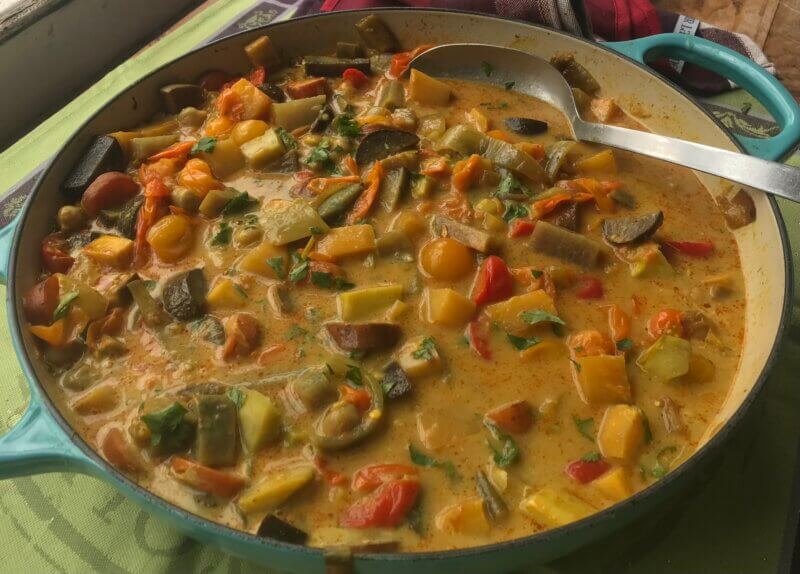Make warming winter curry from locally grown ingredients
It’s February, and we need something to warm us up. The gardens are frozen, most of the farm stands are closed, but we can still serve up delightful meals with the bulk of the ingredients sourced locally.
What produce do we have grown locally in Vermont right now? Roots, of course, but also fresh greens, more roots and frozen vegetables. It’s not as meager as it might sound, and it will be a few months yet before we see green sprouts growing in the fields outside.
On a recent Saturday, I surveyed the results of my hunter-gathering efforts and discovered I had compiled a beautiful rainbow of produce grown in our area at Bread and Butter Farm. Yes, they were primarily root vegetables and greens, but pretty they were, and they did not have to travel across the country or world to make their way to our table.

A warming curry, using locally grown ingredients, adds some vibrant color to the table, satisfying the eyes as well as the body.
So many possibilities. A soup perhaps, or a stew? Maybe a casserole. It was a cold day, so I decided on a flavorful curry and all the accompaniments.
From my freezer, I retrieved a pint of cherry tomatoes from my own garden, local chopped red peppers from last summer and ginger from Philo Ridge farm. I tucked several of these large rhizomes in the freezer last fall; frozen ginger grates easier than fresh, so when you find a good source, freezing is a great option, and many Vermont farmers are growing ginger now. Just grate what you need and put the rest back in the freezer.
The only ingredients in this curry that are not local are the exotic spices, chick peas and coconut milk, but I wouldn’t be surprised if some enterprising Vermont farmer figured out how to grow palm trees in the near future as well.
The vegetables here are suggestions. If you like golden beets or sweet potatoes, add those; if you don’t like turnips, substitute something else. Cauliflower is also lovely in this, but use what you like and can find, just try to use vegetables of many colors of the rainbow to please the eye as well as the body.
A warming winter curry
Make this vegetable curry as hot or mild as you like by adjusting the pepper and cayenne. In a large, heavy bottom pot, heat:
2 tablespoons olive oil
Once hot, add:
1 large purple or yellow onion, sliced
Cook for five minutes or so until the onions soften and start to brown, then add:
3 cloves of garlic, minced
1 serrano or jalapeno pepper, minced
2 tablespoons finely minced or grated fresh ginger
1 teaspoon ground turmeric
2 teaspoons garam masala
1 teaspoon anise or fennel seeds
1/2 teaspoon cayenne pepper
Stir the mixture for a minute or so, until the spices bloom and fill your kitchen with tantalizing aromas. This is a step you don’t want to skip, because the spices will release their aromatics better when heated in oil. Add your vegetables, which you have chopped up into similar size:
2 cups rutabaga, chopped
2 cups purple- or yellow-fleshed potatoes, chopped
1 cup carrots or parsnips, sliced into coins
2 cups daikon radish or spicy turnip, chopped
Stir everything together well, let cook for a few minutes, then add:
1 cup water
1 pint of cherry tomatoes, fresh or frozen
½ cup chopped sweet pepper, fresh or frozen
Bring to a boil, cover and simmer for 20 minutes, or until the vegetables are tender.
Gently stir in:
1 can organic, unsweetened coconut milk, light if you like
2 cups chickpeas, cooked, or 1 can chickpeas, no salt added, drained
Simmer on lowest heat for another 15 minutes and check seasoning, adding salt and pepper if desired. When done, top with:
Juice of one lime
Chopped cilantro or parsley
Serve this vegetable curry with jasmine or basmati rice, or naan bread if you can find it. Traditionally, a cooling cucumber raita (recipe below) is often served on the side, especially if you make the curry hot.
Raita
Raita can become watery if you don’t rid the cucumbers of as much moisture as possible. To do this, salt and drain to extract that water.
Shred:
1 large English cucumber
Place in a colander and sprinkle with:
2 teaspoon salt
Let this sit for 15 to 30 minutes, then rinse and squeeze the water out. Place in a large bowl and add:
1 cup plain Greek yogurt, local of course
2 tablespoon fresh mint, minced
2 tablespoon fresh parsley or cilantro, minced
½ teaspoon garam masala
½ teaspoon salt
Mix everything together. To serve, top with a little sweet paprika and more chopped herbs.
